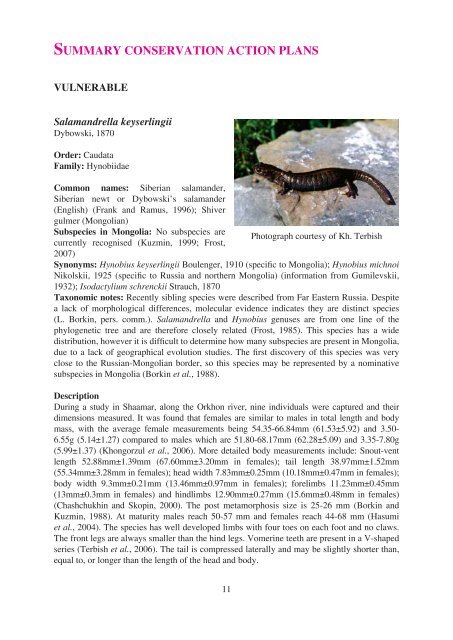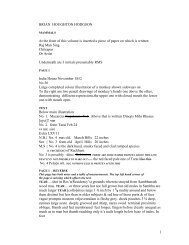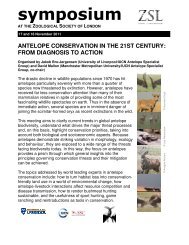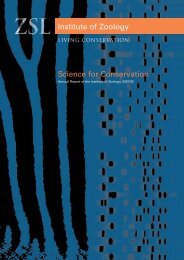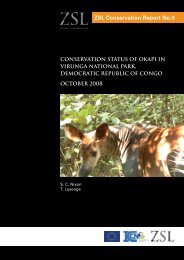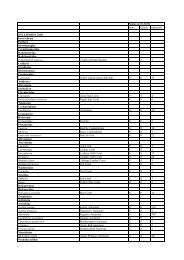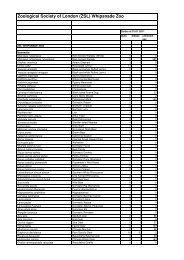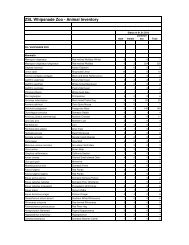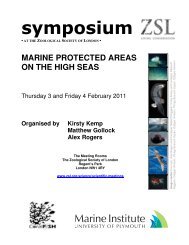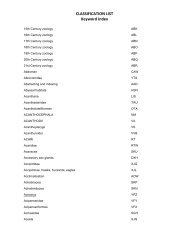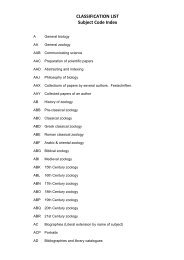Summary Conservation Action Plans for Mongolian Reptiles and ...
Summary Conservation Action Plans for Mongolian Reptiles and ...
Summary Conservation Action Plans for Mongolian Reptiles and ...
Create successful ePaper yourself
Turn your PDF publications into a flip-book with our unique Google optimized e-Paper software.
SUMMARY CONSERVATION ACTION PLANS<br />
VULNERABLE<br />
Salam<strong>and</strong>rella keyserlingii<br />
Dybowski, 1870<br />
Order: Caudata<br />
Family: Hynobiidae<br />
Common names: Siberian salam<strong>and</strong>er,<br />
Siberian newt or Dybowski’s salam<strong>and</strong>er<br />
(English) (Frank <strong>and</strong> Ramus, 1996); Shiver<br />
gulmer (<strong>Mongolian</strong>)<br />
Subspecies in Mongolia: No subspecies are<br />
currently recognised (Kuzmin, 1999; Frost,<br />
2007)<br />
Synonyms: Hynobius keyserlingii Boulenger, 1910 (specifi c to Mongolia); Hynobius michnoi<br />
Nikolskii, 1925 (specifi c to Russia <strong>and</strong> northern Mongolia) (in<strong>for</strong>mation from Gumilevskii,<br />
1932); Isodactylium schrenckii Strauch, 1870<br />
Taxonomic notes: Recently sibling species were described from Far Eastern Russia. Despite<br />
a lack of morphological differences, molecular evidence indicates they are distinct species<br />
(L. Borkin, pers. comm.). Salam<strong>and</strong>rella <strong>and</strong> Hynobius genuses are from one line of the<br />
phylogenetic tree <strong>and</strong> are there<strong>for</strong>e closely related (Frost, 1985). This species has a wide<br />
distribution, however it is diffi cult to determine how many subspecies are present in Mongolia,<br />
due to a lack of geographical evolution studies. The fi rst discovery of this species was very<br />
close to the Russian-<strong>Mongolian</strong> border, so this species may be represented by a nominative<br />
subspecies in Mongolia (Borkin et al., 1988).<br />
Description<br />
During a study in Shaamar, along the Orkhon river, nine individuals were captured <strong>and</strong> their<br />
dimensions measured. It was found that females are similar to males in total length <strong>and</strong> body<br />
mass, with the average female measurements being 54.35-66.84mm (61.53±5.92) <strong>and</strong> 3.50-<br />
6.55g (5.14±1.27) compared to males which are 51.80-68.17mm (62.28±5.09) <strong>and</strong> 3.35-7.80g<br />
(5.99±1.37) (Khongorzul et al., 2006). More detailed body measurements include: Snout-vent<br />
length 52.88mm±1.39mm (67.60mm±3.20mm in females); tail length 38.97mm±1.52mm<br />
(55.34mm±3.28mm in females); head width 7.83mm±0.25mm (10.18mm±0.47mm in females);<br />
body width 9.3mm±0.21mm (13.46mm±0.97mm in females); <strong>for</strong>elimbs 11.23mm±0.45mm<br />
(13mm±0.3mm in females) <strong>and</strong> hindlimbs 12.90mm±0.27mm (15.6mm±0.48mm in females)<br />
(Chashchukhin <strong>and</strong> Skopin, 2000). The post metamorphosis size is 25-26 mm (Borkin <strong>and</strong><br />
Kuzmin, 1988). At maturity males reach 50-57 mm <strong>and</strong> females reach 44-68 mm (Hasumi<br />
et al., 2004). The species has well developed limbs with four toes on each foot <strong>and</strong> no claws.<br />
The front legs are always smaller than the hind legs. Vomerine teeth are present in a V-shaped<br />
series (Terbish et al., 2006). The tail is compressed laterally <strong>and</strong> may be slightly shorter than,<br />
equal to, or longer than the length of the head <strong>and</strong> body.<br />
11<br />
Photograph courtesy of Kh. Terbish


